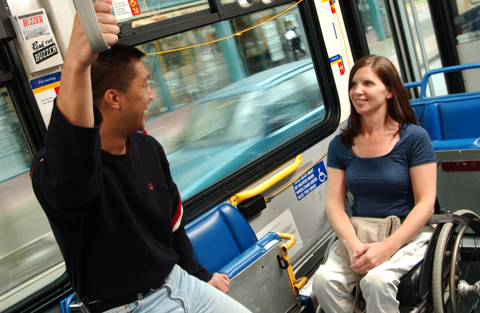An Access Awareness Day quiz!
An Access Awareness Day quiz!
Again, it’s Access Awareness Day on Saturday June 5, so we’re exploring accessibility on the blog this week!
Today, here’s a seven-question quiz about accessibility and disabilities, devised by a colleague from the Access Transit department.
Give it a try and see how many you can get right. I found some of them a bit tricky, I’ll warn you.
- Which of the following are under the classification of ‘disability’? (Pick all that apply.)
A. Broken Leg
B. Person in a Wheelchair
C. Deaf or Hearing Impaired
D. Spinal Cord Injury
E. Stuttering
F. Dyslexia
G. Depression
H. Anxiety and Panic Disorder
I. Chronic Fatigue Syndrome - When referring to those under the classification of “disability” what phrases are generally acceptable? (Pick all that apply.)
A. Person in a wheelchair
B. Disabled
C. People with disabilities
D. Stroke victim
E. Handicapped
F. Physically challenged
G. Autistic child
H. A child who has autism
I. Vision impaired
J. Visually impaired
K. Deaf
L. Hard of hearing
M. Hearing impaired - When interacting with people who have disabilities which of the following are acceptable? (Pick all that apply.)
A. Leading someone with a visual impairment after having first asked for their permission
B. Help someone by pushing their manual chair
C. When speaking with someone lean against their wheelchair
D. Touch the arm of someone who has a hearing impairment to get their attention before speaking to them
E. Talking loudly or slowly to someone with a hearing impairment
F. Helping a person who stutters finish their words or sentences
G. Asking someone with a speech disability to repeat what they have said or to ask them to put it into a way so that you can understand what they are saying.
H. Saying to someone with a visual impairment that you will “see them later” - Hannah uses a wheelchair and has 25% vision. How does she prefer people refer to her?
- How do people who are born blind tell the difference between the denominations of the Canadian bills?
- What is the width needed for a chair to get through aisles, doors, and hallways?
- According to SPARC (Social Planning and Research Council) what percentage of the recreation, retail, entertainment, workplace and housing markets do people with disabilities represent?
– 5-10%
– 10-15%
– 15-20%
– 20-25%
– 25-30%
Answers can be found in this PDF!







“Hearing impaired” is actually frowned upon in many circles. Better to use “Deaf” and “Hard of Hearing.”
How we refer to the disabled is largely due to our age, our upbringing, and often times the disability.
My uncle, disabled from birth, has no problem referring to himself as crippled. In some ways, I have to agree. “Crippled” is a lot more accurate in conveying the type of disability and doesn’t hide behind being politically correct.
I’m hard of hearing. Sungsu is absolutely correct in saying that I might be insulted with the term “hearing impaired”. Of course, I would be insulted with “deaf” as well because I tend to think of words like blind and deaf as absolutes.
That’s really interesting Cliff: cultural and historical contexts certainly do change what words are deemed acceptable and what people are comfortable with.
Since we’re on the topic, there is also the issue of “Deaf” with capital D. “Deaf” refers to the community and culture of those who communicate with primarily sign language. It’s similar to saying somebody is Canadian or Chinese. What the Deaf community really hate, though, is being referred to as “deaf and dumb” – hugely demeaning.